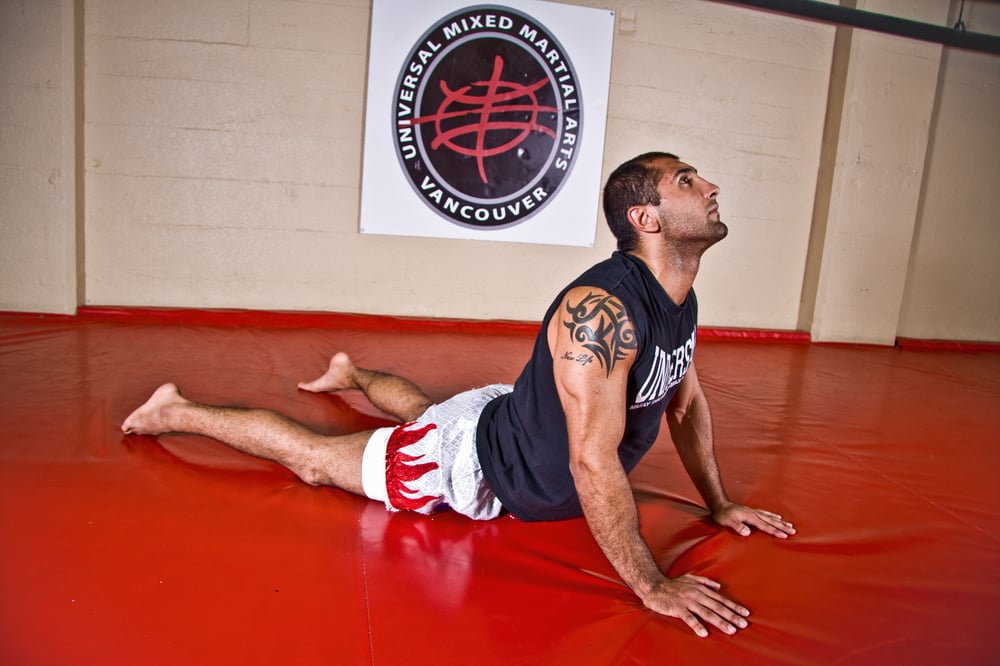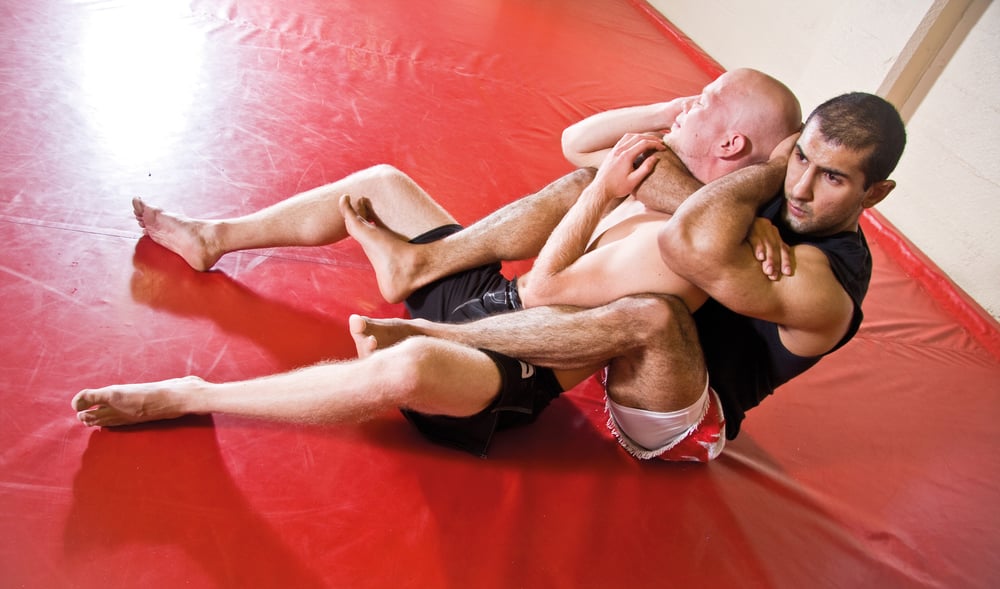
Issue 058
January 2010
By Harry Toor.
Back injuries are incredibly common across a large number of sports. Mixed martial arts has its own specific rigors and with its increasing popularity we are seeing more and more cases of back pain from MMA come into our clinic.
This increase has led some health practitioners to mistakenly believe that MMA is the problem and should be avoided. In fact, martial arts are very effective at keeping the back healthy. You would be hard-pressed to find athletes as well conditioned as fighters who train properly.
For those who start late or don’t train ‘properly’, MMA can be a fast track to injury. To avoid these injuries, one should understand some basic biomechanical principles specific to MMA relating to flexibility, movement and core strength.

FLEXIBILITY
Spinal flexibility
The importance of spinal flexibility in preventing back injury is common knowledge for anyone involved in MMA. It prevents soft tissue injuries in the form of sprains (affecting ligaments), strains (tendon or muscle), disc and even facet (spinal) joint injuries. Flexibility becomes even more necessary as we age, because our ligaments, tendons and joint capsules slowly lose elastin, resulting in decreased elasticity and further susceptibility to injury.
There is no quicker way to injure your spine than attempting difficult techniques before the proper spinal flexibility is achieved. Improving your overall range of motion, as well as strengthening your spine through the full range of movement, will protect you.
Relative mobility
The flexibility of joints away from the lower back allows forces to be exerted appropriately at the low back. Each body movement is made up of a chain of movements through various joints. Each joint in the body was built for a particular kind of movement. If there is inadequate mobility in one joint, greater stress will be exerted on the next joint in the chain, which can result in an instability or injury.
For example, stiffness in the hips and mid-back (both areas built very well for rotation), can place a lot of rotational strain on the lower back. Rotation stress is a major factor in both disc and facet joint injuries.

CORE STRENGTH
Solid core stability
Core stability refers to the ability of the body to hold its core (low back and pelvis) stable, especially as forces are traveling up from the lower extremities, or down from the upper extremities. The previously discussed principles indirectly help keep the core stable by minimizing the sheer forces exerted on it. The more direct form of core stability comes from the strength and function of the large bracing muscles (erector spinae, latissimus dorsi, gluteus maximus, rectus abdominus and the obliques), as well as the deep stabilizing muscles (transversus abdominus, pelvic floor, multifidus). Both groups of muscles are equally important.
Training MMA will build these areas up naturally, but what to focus on will depend entirely on the individual’s weaknesses or muscle imbalances. One common muscle imbalance is dominance of the hip flexors and superficial abdominal muscles, with weakness in the deeper core-muscles. Ex-athletes after a lengthy hiatus often present this way, as they used to rely heavily on core muscle strength, but let it waste away with inactivity.
In these situations, conventional abdominal exercises often exacerbate the problem because they focus on the rectus abdominus (six-pack muscles), external obliques and hip flexors. Training the deep core-muscles requires time and patience in the beginning to learn how to control them, before progressing to more advanced stabilization exercises.
People who don’t understand MMA often view it as too stressful or damaging for those with back injuries, while in fact there are few better ways to help build a stronger back. With correct training and knowledge of the underlying mechanics, you can actually continue training and fix MMA-induced back injuries far better than any massage or ice pack, and it will help you prevent any future setbacks as well.

MOVEMENT
Proper movement technique – proximal to distal
Proximal-to-distal movement patterning means moving first from the center of the body then through to the end of the extremity (i.e. fist, foot, elbow, etc). One of the earliest things students of most striking styles will learn is that the punch or kick is initiated from hip. It has been taught this way for centuries because it is the best way to generate power, but it also helps tremendously in preventing injuries by reducing the unchecked forces traveling through the joints. This concept seems obvious in the world of martial arts, but it’s often considered a novel approach when applied to other sports.
This proximal-to-distal movement pattern can also be promoted during cross-training or weight training by incorporating basic functional movements (squat, lunge, push, pull, etc). Kettlebell training for MMA is gaining popularity because it involves the entire body during functional movement patterns that apply directly to the sport.

Fluidity of movement
Fluidity of movement refers to controlled, steady (not necessarily slow) movement, which minimizes the excessive movement or strain placed on the various joints involved. Regardless of the sport, we can always find those special athletes that make everything look easy and natural. In MMA, Anderson Silva’s striking or Shinya Aoki’s grappling demonstrate this. What’s really happening is that movement is being done very efficiently, where there are little or no wasted smaller movements making up the bigger body movement. True, some people are more naturally gifted in this department, but it can always be further developed by practicing proper technique.
Fluidity of movement can be trained directly by refining the techniques, or even indirectly by choosing other exercises that use similar movements to the style you are practicing. The latter concept is called sport specific training. Also, concentrating on proper footwork creates a stable base of support, further promoting fluid movement.
Harry Toor is a sport physical therapist and owner of Envision Physiotherapy in Vancouver, BC, Canada. For more information go to www.VancouverSportsPhysio.com. Photos courtesy of Alex Law, www.alexlaw.dphoto.com, shot on location at Universal MMA, Vancouver, www.universalmma.com.
...









